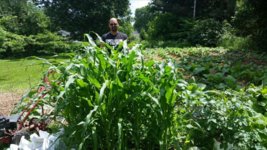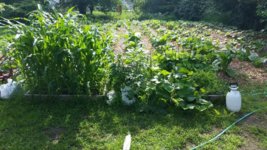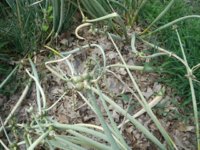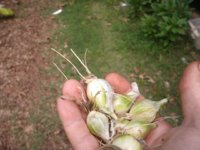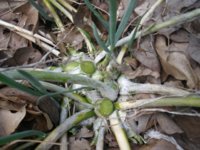You are using an out of date browser. It may not display this or other websites correctly.
You should upgrade or use an alternative browser.
You should upgrade or use an alternative browser.
let's see your veggie garden {pics}
- Thread starter Chicken
- Start date
- Status
- Not open for further replies.
Boboro
Well-Known Member
I hope to sell a bunch to the farmers market. Most years I don't dig most of it.
I hope to sell a bunch to the farmers market. Most years I don't dig most of it.
i do that sometimes. at least i have in the past...
take a nice haul i got out of the garden, and take it to a local produce stand. and see what the guy will give me for all of it.
............................my corn is looking very sexy. i got small ears forming,
Brown Thumb
Well-Known Member
You like corn too. Mee three. I freeze mine also in the husk with newspaper, Nothing Better than a unfrozen grilled worm..my corn is looking very sexy. i got small ears forming,
My delectable corn, Yes Hybrid. Trying something different this year and it is doing great.
3 rows two weeks apart with 3 rows of plants in each row.
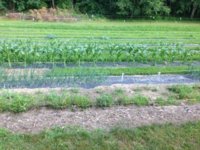
grgfinney
Well-Known Member
i so need a camera.... i'd like to show you my corn..
im amazinglly impressed with this years crop.
but i do work for a fertilizer company.. '' just what did you think my crop was going to do ''
im amazinglly impressed with this years crop.
but i do work for a fertilizer company.. '' just what did you think my crop was going to do ''
grgfinney
Well-Known Member
Just rabbit poo and worm tea
grgfinney
Well-Known Member
i so need a camera.... i'd like to show you my corn..
im amazinglly impressed with this years crop.
but i do work for a fertilizer company.. '' just what did you think my crop was going to do ''
No camera? Yeah right. No camera and you suddenly have the best patch, best garden, biggest truck, hottest old lady, yada yada yada. No pictures, it didn't happen. (Just ragging you Chickenhawk, get a damn camera)
^^^^^^
lol/// i got a CAMERA but i think it's smarter than i am...
so look for a upcoming thread by me.... im gonna start taking this thing to ...work with me.. i see so much cool.. and '' old '' stuff dealing with farming.
im gonna start a north florida farming picture thread.
i wish i'd have had it 3 days ago. i seen a very old '' all steel tire'' tractor.
but tomorrow im gonna get some pictures of my grow.. veggies and bacca.



lol/// i got a CAMERA but i think it's smarter than i am...
so look for a upcoming thread by me.... im gonna start taking this thing to ...work with me.. i see so much cool.. and '' old '' stuff dealing with farming.
im gonna start a north florida farming picture thread.
i wish i'd have had it 3 days ago. i seen a very old '' all steel tire'' tractor.
but tomorrow im gonna get some pictures of my grow.. veggies and bacca.
American Hazelnut

Hazels in their 4th growing season.
I planted two American Hazels (they were just twigs) in March of 2011. I think I paid $1 each. As the name suggests, they (or related species) grow wild throughout the US. Unlike most nuts, hazels (also called filberts) prefer to grow as a shrub, and seldom reach over 8 feet in height. This is their first year bearing nuts.

You can prune them to form a small tree, but they annually form multiple ground suckers, and want to be a bush.
You may have hazels on your property, or nearby. These wild hazels are unimposing, quite ordinary looking shrubs. The fruit is hidden. Last summer, while hiking a mountain bald along the Appalachian Trail, I noticed a vast stand of hazels at the margins, some reaching over 12 feet.




The fruit is usually well hidden by the foliage. One, two, or sometimes three nuts will develop within a single fruiting body.

The traditional method of harvesting hazelnuts is to wait for the husks to dry in the fall, causing the nuts to conveniently drop onto the ground. Unfortunately, squirrels and other critters know all about this. Often they will climb into the hazel and eat the nuts before they drop.
You can harvest them before the squirrels by waiting until you see brownish spots developing on the light green husk. Just twist the fruit off, and place them in a dry place for a month or so.
American hazelnuts are smaller than the European filbert sold in grocery stores.

Another fan of the American hazel.
Bob
EDIT: I forgot to mention that hazel leaves contain tannin. If you include a green hazel leaf into a batch of pickles, it will make them a little more crisp. Hazel leaves turn yellow or red in the autumn, making them attractive inside a pickle jar.

Hazels in their 4th growing season.
I planted two American Hazels (they were just twigs) in March of 2011. I think I paid $1 each. As the name suggests, they (or related species) grow wild throughout the US. Unlike most nuts, hazels (also called filberts) prefer to grow as a shrub, and seldom reach over 8 feet in height. This is their first year bearing nuts.

You can prune them to form a small tree, but they annually form multiple ground suckers, and want to be a bush.
You may have hazels on your property, or nearby. These wild hazels are unimposing, quite ordinary looking shrubs. The fruit is hidden. Last summer, while hiking a mountain bald along the Appalachian Trail, I noticed a vast stand of hazels at the margins, some reaching over 12 feet.




The fruit is usually well hidden by the foliage. One, two, or sometimes three nuts will develop within a single fruiting body.

The traditional method of harvesting hazelnuts is to wait for the husks to dry in the fall, causing the nuts to conveniently drop onto the ground. Unfortunately, squirrels and other critters know all about this. Often they will climb into the hazel and eat the nuts before they drop.
You can harvest them before the squirrels by waiting until you see brownish spots developing on the light green husk. Just twist the fruit off, and place them in a dry place for a month or so.
American hazelnuts are smaller than the European filbert sold in grocery stores.

Another fan of the American hazel.
Bob
EDIT: I forgot to mention that hazel leaves contain tannin. If you include a green hazel leaf into a batch of pickles, it will make them a little more crisp. Hazel leaves turn yellow or red in the autumn, making them attractive inside a pickle jar.
Chives seed collecting
The beautiful purple chive flowers of spring turn into dull, dry, puffy balls by late June.

Squeezing the seedhead will release the black seeds into your hand.

Chives propagate like bunching onions, beneath the soil, but you can also start chives from seed.
Bob
The beautiful purple chive flowers of spring turn into dull, dry, puffy balls by late June.

Squeezing the seedhead will release the black seeds into your hand.

Chives propagate like bunching onions, beneath the soil, but you can also start chives from seed.
Bob
Boboro
Well-Known Member
Boboro
Well-Known Member
I've been meaning to plant some Chestnut trees from China since all of America's Chestnut trees were wiped out by the blight. I haven't gotten around to it yet, but I like the looks of those Hazelnut bushes also. I may have to make some room for some of them too.
DGBAMA
Well-Known Member
Hazel has been on my wish list for years. Still haven't done it.
Brown Thumb
Well-Known Member
I would like to try that leaf in my pickel jars. I do at least 50 Qts. A year.
Thanks for Sharing.
BT.
Thanks for Sharing.
BT.
The Arbor Day Foundation offers American Hazel Nut trees. The membership is $10, but you can select 10 free trees.
http://www.arborday.org/shopping/trees/treeImages.cfm?ID=106
Bob
http://www.arborday.org/shopping/trees/treeImages.cfm?ID=106
Bob
BarG
Founding Member
American Hazelnut

Hazels in their 4th growing season.
Wow, what a fine garden. speaking of squirrels and coons how do you beat them to the punch?
Last edited by a moderator:
For most of my critter problems, I try to out-produce their demand, hoping that some local predators will notice all the well-fed bunnies and squirrels.
Bob
Bob
- Status
- Not open for further replies.
Similar threads
- Replies
- 628
- Views
- 89K
- Replies
- 20
- Views
- 4K
- Replies
- 2
- Views
- 1K
- Replies
- 6
- Views
- 2K
- Replies
- 3
- Views
- 3K
-
About Us
This forum is dedicated to promoting the American tobacco farmer and tobacco home growers across the globe. Whether you grow by the acre, in your backyard, or in pots, you should find valuable and accurate information here.We discuss any variety of tobacco, as well as numerous approaches to growing, harvesting, curing, and finishing your crop. Our members will attempt to provide experience-based answers to your questions.
-
Buy raw tobacco from our Sponsor - WLT


